Fluid coupling is also known as hydraulic coupling. It is a hydrodynamic device that is used to transfer rotational power from one shaft to another by the use of transmission fluid. It is used in the automotive transmission system, marine propulsion system, and in industries for power transmission. It is used as an alternative to the mechanical clutch.
It was discovered by Dr. Hermann Fottinger. He patented his discovery of fluid coupling and torque converter in the year 1950.
Main Parts of Fluid Coupling
It consists of three main components
1. Housing:
It is also known as the shell. It has an oil-tight seal around the drive shaft. It also protects the impeller and turbine from outside damage.
2. Impeller or pump:
It is a turbine which is connected to the input shaft and called an impeller. It is also known as a pump because it acts as a centrifugal pump.
3. Turbine:
It is connected to the output shaft to which the rotational power is to be transmitted.
Also Read:
- Different Types of Engine
- Ignition Coil – Main Parts, Working Principle and Application
- What is a Magneto Ignition System and How It Works?
The impeller is connected to the prime mover (internal combustion engine) which is a power source. The turbine is connected to the output shaft where rotation power is needed to be transmitted. The impeller and turbine are enclosed in an oil-tight sealed housing. The housing consists of transmission fluid.
Working Principle
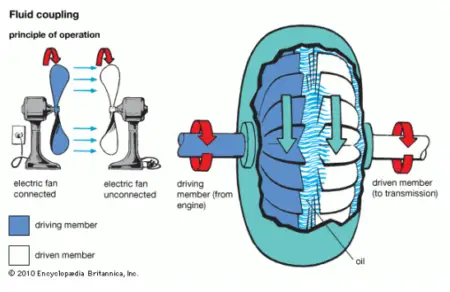
The working principle of fluid can be easily explained by taking two fans in which one is connected to the power supply and the other is not. When the power switch is ON, the air from the first fan starts to blow towards the second fan (which is not connected to the power source). Initially, when the first fan is blowing at a lower speed, it is not able to drive the second fan. But as the speed of the powered fan increases, the speed of air striking the blades of the second fan also increases and it starts to rotate. After some time it acquires the same velocity as that of the first fan.
On the same principle, the fluid coupling works. In that, the impeller acts as the first fan and the turbine acts as the second fan. Both the impeller and turbine are enclosed in an oil-tight housing. The impeller is connected to the input shaft of the prime mover and the turbine with the output shaft. When the impeller is moved by the prime mover, the fluid in the housing experiences a centrifugal force, and due to the curved vanes of the impeller the fluid is directed towards the turbine blades. As the fluid strikes the turbine blades it starts rotating. With the increase in the speed of the impeller, the velocity of the turbine increases and becomes approximately equal to the impeller speed. The fluid after passing through the turbine blades again returns to the impeller.
Also Read:
- How Ignition Distributor Works?
- What is Master Cylinder and How It Works?
- How Power Steering System Works? – Best Explanation
Working of Fluid Coupling
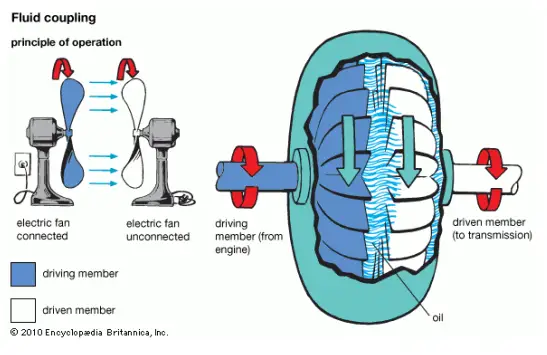
- As the prime mover moves, it rotates the impeller of the coupling. The impeller acts as a centrifugal pump and throws the fluid outward and directs it towards the turbine blade.
- As the high-moving fluid strikes the turbine blades, it also starts rotating, after striking the blades, the direction of the fluid is changed and it is directed towards the impeller again. The blades of the turbine are designed in such a way that it can easily change the direction of the fluid. It is the changing of direction of the fluid that makes the turbine rotate.
- As the impeller speed increases, the speed of the turbine also increases. After some time the speed of both the impeller and the turbine becomes equal. In this way, power is transmitted from one shaft to another by the use of fluid coupling.
- In the same way torque converter works but the difference is that it has a stator placed in between the impeller and turbine for torque multiplication.
For a Better Explanation Watch the Video Given Below:
Application
- It is used in automotive industries for the transmission of power from the engine to the wheel as an alternative to the clutch.
- It is used in marine propulsion systems.
- It is used in various industries for power transmission.
Here we have learned about what is fluid coupling, its main parts, working, and application in detail. If you found this piece of information valuable then don’t forget to like, share, and subscribe to us.

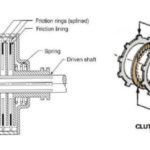


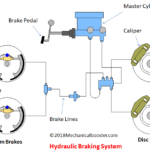


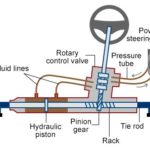


Are both Fluid Coupling & Torque converter used together in Automatic transmission? Or Fluid Coupling isn’t used at all? Please clarify my doubt on this.
yes both torque converter and fluid coupling both are used in automatic transmission. torque convertor is mostly used in automobile like cars, bus, trucks etc.the torque converter works on the principle of fluid coupling.
turbo coupling and toque converter are both types of fluid coupling, the difference is that torque converter has a stator in between to facilitate torque multiplication and reverse of the fluid.